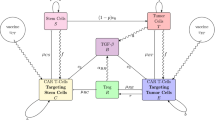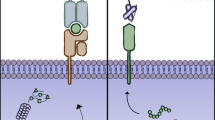Abstract
Chimeric antigen receptor T cell (CAR-T) therapy is a novel approved treatment for hematological malignancies, still under development for solid tumors. Here, we use a rate equation-based mathematical model to discover regimens and schedules that maintain efficacy while potentially reducing toxicity by decreasing the amount of CAR-T infused. Tested on an in vivo murine model of spontaneous breast cancer, we show that our mathematical model accurately recapitulates in vivo tumor growth results achieved in the previous experiments. Moreover, we use the mathematical model to predict results of new therapy schedules and successfully prospectively validated these predictions in the in vivo. We conclude that using one tenth and even one percent of a full CAR-T dose used in preclinical trials can achieve efficacious results similar to full dose treatment.





Similar content being viewed by others
Abbreviations
- CAR:
-
Chimeric antigen receptor
- CTX:
-
Cyclophosphamide
- d:
-
Days
- E/T :
-
Effector/target
- Her2tgm:
-
MMTV.f.huHer2 #5 (Fo5), (Genentech, USA)
References
Gross G, Waks T, Eshhar Z (1989) Expression of immunoglobulin-T-cell receptor chimeric molecules as functional receptors with antibody-type specificity. Proc Natl Acad Sci USA 86(24):10024–10028
Eshhar Z, Waks T, Gross G, Schindler DG (1993) Specific activation and targeting of cytotoxic lymphocytes through chimeric single chains consisting of antibody-binding domains and the gamma or zeta subunits of the immunoglobulin and T-cell receptors. Proc Natl Acad Sci USA 90(2):720–724
Hwu P, Shafer GE, Treisman J, Schindler DG, Gross G, Cowherd R, Rosenberg SA, Eshhar Z (1993) Lysis of ovarian cancer cells by human lymphocytes redirected with a chimeric gene composed of an antibody variable region and the Fc receptor gamma chain. J Exp Med 178(1):361–366
Hwu P, Yang JC, Cowherd R, Treisman J, Shafer GE, Eshhar Z, Rosenberg SA (1995) In vivo antitumor activity of T cells redirected with chimeric antibody/T-cell receptor genes. Cancer Res 55(15):3369–3373
Kershaw MH et al (2006) A phase I study on adoptive immunotherapy using gene-modified T cells for ovarian cancer. Clin Cancer Res 12:6106–6115
Pinthus JH, Waks T, Malina V, Kaufman-Francis K, Harmelin A, Aizenberg I, Kanety H, Ramon J, Eshhar Z (2004) Adoptive immunotherapy of prostate cancer bone lesions using redirected effector lymphocytes. J Clin Investig 114(12):1774–1781
June CH (2011) Chimeric antigen receptor-modified T cells in chronic lymphoid leukemia. N Engl J Med 365(8):725–733
Stancovski I, Schindler DG, Waks T, Yarden Y, Sela M, Eshhar Z (1993) Targeting of T lymphocytes to Neu/HER2-expressing cells using chimeric single chain Fv receptors. J Immunol 151(11):6577–6582
Vera J, Savoldo B, Vigouroux S, Biagi E, Pule M, Rossig C, Wu J, Heslop HE, Rooney CM, Brenner MK, Dotti G (2006) T lymphocytes redirected against the kappa light chain of human immunoglobulin efficiently kill mature B lymphocyte-derived malignant cells. Blood 108(12):3890–3897
Zhao Y, Wang QJ, Yang S, Kochenderfer JN, Zheng Z, Zhong X, Sadelain M, Eshhar Z, Rosenberg SA, Morgan RA (2009) A herceptin-based chimeric antigen receptor with modified signaling domains leads to enhanced survival of transduced T lymphocytes and antitumor activity. J Immunol 183(9):5563–5574
Maliar A, Servais C, Waks T, Chmielewski M, Lavy R, Altevogt P, Abken H, Eshhar Z (2012) Redirected T cells that target pancreatic adenocarcinoma antigens eliminate tumors and metastases in mice. Gastroenterology 143(5):1375–1384
Kohn DB, Dotti G, Brentjens R, Savoldo B, Jensen M, Cooper LJ et al (2011) CARs on track in the clinic. Mol Ther 19(3):432–438. https://doi.org/10.1038/mt.2011.1
Lee DW, Barrett DM, Mackall C, Orentas R, Grupp SA (2012) The future is now: chimeric antigen receptors as new targeted therapies for childhood cancer. Clin Cancer Res 18(10):2780–2790
Porter DL, Levine BL, Kalos M, Bagg A, June CH (2011) Chimeric antigen receptor-modified T cells in chronic lymphoid leukemia. N Engl J Med 365(8):725–733
Rosenberg SA (2011) 2011 Cell transfer immunotherapy for metastatic solid cancer–what clinicians need to know. Nat Rev Clin Oncol 8(10):577–585. https://doi.org/10.1038/nrclinonc.2011.116
Cruz CR, Micklethwaite KP, Savoldo B, Ramos CA, Lam S, Ku S et al (2013) Infusion of donor-derived CD19-redirected virus-specific T cells for B-cell malignancies relapsed after allogeneic stem cell transplant: a phase 1 study. Blood 122(17):2965–2973
Slaney CY, von Scheidt B, Davenport AJ, Beavis PA, Westwood JA, Mardiana S et al (2017) Dual-specific chimeric antigen receptor T cells and an indirect vaccine eradicate a variety of large solid tumors in an immunocompetent, self-antigen setting. Clin Cancer Res 23(10):2478–2490
Kochenderfer JN, Somerville RPT, Lu T, Shi V, Bot A, Rossi J et al (2017) Lymphoma remissions caused by anti-CD19 chimeric antigen receptor T cells are associated with high serum interleukin-15 levels. J Clin Oncol 35(16):1803–1813
Kochenderfer JN, Somerville RPT, Lu T, Yang JC, Sherry RM, Feldman SA et al (2017) Long-duration complete remissions of diffuse large B cell lymphoma after anti-CD19 chimeric antigen receptor T cell therapy. Mol Ther 25(10):2245–2253
Irving M, Vuillefroy de Silly R, Scholten K, Dilek N, Coukos G (2017) Engineering chimeric antigen receptor T-cells for racing in solid tumors: don't forget the fuel. Front Immunol. 3(8):267. https://doi.org/10.3389/fimmu.2017.00267 (eCollection 2017)
Wang X, Rivière I (2016) Clinical manufacturing of CAR T cells: foundation of a promising therapy. Mol Ther Oncolytics 3:16015
Murray JD (2002) Mathematical biology I: an introduction. Springer, Berlin
Edelshtein-Keshet L (1988) Mathematical models in biology. Mcgraw-Hill, Boston
Segel L (1980) Mathematical models in molecular and cellular biology. Cambridge University Press, Cambridge
Kuznetsov V, Makalkin I, Taylor M, Perelson A (1994) Nonlinear dynamics of immunogenic tumors: parameter estimation and global bifurcation analysis. Bull Math Biol 2(56):295–321
Kirschner D, Panetta J (1998) Modeling immunotherapy of the tumor–immune interaction. J Math Biol 37:235–252
de Pillis LG, Radunskaya AE, Wiseman CL (2005) A validated mathematical model of cell-mediated immune response to tumor growth. Cancer Res 65(17):7950–7958
Bunimovich-Mendrazitsky S, Halachmi S, Kronik N (2016) Improving Bacillus Calmette-Guérin (BCG) immunotherapy for bladder cancer by adding interleukin 2 (IL-2): a mathematical model. Math Med Biol 33(2):159–188. https://doi.org/10.1093/imammb/dqv007
Michor F, Hughes T, Iwasa Y, Branford S, Shah N, Sawyers C, Nowak M (2005) Dynamics of chronic myeloid leukemia. Nature 435:1267–1270
Kronik N, Kogan Y, Vainstein V, Agur Z (2008) Improving alloreactive CTL immunotherapy for malignant gliomas using a simulation model of their interactive dynamics. Cancer Immunol Immunother 57:425–439
Kronik N, Kogan Y, Elishmereni M, Halevi-Tobias K, Vuk-Pavlović S, Agur Z (2010) Predicting outcomes of prostate cancer immunotherapy by personalized mathematical models. PLoS ONE 5(12):e15482
Kronik N, Kogan Y, Schlegel PG, Wolfl M (2012) Improving T-cell immunotherapy for melanoma through a mathematically motivated strategy: efficacy in numbers? J Immunother 35(2):116–124
Globerson Levin A, Waks T, Eshhar Z (2014) Elimination of progressive mammary cancer by repeated administrations of chimeric antigen receptor-modified T cells. Mol Ther 22(5):1029–1038
Narod SA (2012) Disappearing breast cancers. Curr Oncol 19(2):59–60
Finkle D, Quan ZR, Asghari V, Kloss J, Ghaboosi N, Mai E et al (2004) HER2-targeted therapy reduces incidence and progression of midlife mammary tumors in female murine mammary tumor virus huHER2-transgenic mice. Clin Cancer Res 10(7):2499–2511
Mojic M, Takeda K, Hayakawa Y (2017) The dark side of IFN-γ: its role in promoting cancer immunoevasion. Int J Mol Sci 19(1):89
Sharma P, Hu-Lieskovan S, Wargo JA, Ribas A (2017) Primary, adaptive, and acquired resistance to cancer immunotherapy. Cell 168(4):707–723
Funding
VV is supported by the I-CORE Program of the Planning and Budgeting Committee and The Israel Science Foundation under Grant Number 41/11.
Author information
Authors and Affiliations
Contributions
AGL was involved in study conception, study design, critical revision of the manuscript, data acquisition, data interpretation, and statistical analysis. NK was involved in study conception, study design, critical revision of the manuscript, data acquisition, data interpretation, and mathematical model development. TS was involved in study design and data interpretation. TW was involved in study conception, study design, critical revision of the manuscript, and data interpretation. ZE was involved in study conception, study design, critical revision of the manuscript, and data interpretation. VV was involved in study conception, study design, critical revision of the manuscript, and data interpretation.
Corresponding author
Ethics declarations
Conflict of interest
Zelig Eshhar is a member of the Scientific Advisory Board of Kite Pharma Inc. All other authors declare no conflict of interests.
Ethical approval and ethical standard
All animal experiments were performed in compliance with the guidelines of the Institutional Animal Care and Use Committee of TASMC. Ethical Approval Number 33-11-13 (2013 for 4 years). FVB and Her2tgm (Genentech, USA) mice were used.
Animal source
MMTV.f.huHer2 #5(Fo5) transgenic male mice (a gift from Genentech, San Francisco, CA). Female mice for mating were purchased from Envigo, Israel.
Cell line authentication
Mouse lymphocytes were obtained from splenocytes of FVB female mice.
Additional information
Publisher's Note
Springer Nature remains neutral with regard to jurisdictional claims in published maps and institutional affiliations.
Electronic supplementary material
Below is the link to the electronic supplementary material.
Rights and permissions
About this article
Cite this article
Globerson Levin, A., Kronik, N., Shiloach, T. et al. Less is more: reducing the number of administered chimeric antigen receptor T cells in a mouse model using a mathematically guided approach. Cancer Immunol Immunother 69, 1165–1175 (2020). https://doi.org/10.1007/s00262-020-02516-9
Received:
Accepted:
Published:
Issue Date:
DOI: https://doi.org/10.1007/s00262-020-02516-9




